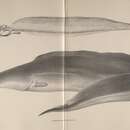Diagnostic Description
provided by Fishbase
Diagnosis: body very elongate (Ref. 28714, 81275), anguilliform (Ref. 81275), its depth 7.2-10.6 times in SL, and covered with tiny scales (Ref. 2915, 81275). Lateral line complete (Ref. 81275). Dorsal fin soft-rayed, extending almost over the entire length of back (Ref. 81275), stopping short of a naked tail (Ref. 28714). Pelvic, anal and caudal fins absent (Ref. 28714, 81275), body ending in a thin/sharp point (Ref. 2915, 81275). Pectoral fins reduced (Ref. 81275), 1.9-5.0 times in head length (Ref. 2915, 81275). Head naked, its length 5.6-6.9 times in SL; snout prominent (Ref. 2915, 81275). Mouth large and terminal; teeth strong, pointed or notched, aligned in a single row in both jaws, 12-16 in upper, 22-28 in lower jaw; premaxillae, as well as vomer and palatines, coalesced; maxillae, vomer and palatines toothless; eye very small, without a free margin (covered by skin); only the left gonad is developed and functional (Ref. 81275).Coloration: dark grey to almost black, darker posteriorly; belly whitish (Ref. 81275).
Life Cycle
provided by Fishbase
Breeds in well-vegetated, marginal areas of swamps and rivers, where a large, floating nest, about 1 m in diameter, is constructed, in which the eggs are laid and later guarded by one of the parents (Ref. 27583). Distinct pairing (Ref. 205).
Migration
provided by Fishbase
Potamodromous. Migrating within streams, migratory in rivers, e.g. Saliminus, Moxostoma, Labeo. Migrations should be cyclical and predictable and cover more than 100 km.
- Recorder
- Crispina B. Binohlan
Morphology
provided by Fishbase
Dorsal spines (total): 0; Dorsal soft rays (total): 183230
Trophic Strategy
provided by Fishbase
Following flooding of the river banks (Gambia River), this species builds large elliptical floating nests in densely vegetated swamps at depths of about 1-1.5 m; lays about 1000 `amber-like' eggs; larvae hatching after 5 days (Ref. 10609). Feeds on crustaceans, insects and fish.
- Recorder
- Drina Sta. Iglesia
Biology
provided by Fishbase
Obligate air-breathing (Ref. 118411, 126274). Inhabits marginal vegetation and swamps constructing a flask-shaped nest in vegetation during the floods, which it is reputed to defend with vigour (Ref. 28714). Following flooding of the Gambia River banks, large elliptical floating nests are build in densely vegetated swamps at depths of about 1-1.5 m, in which about 1000 âamber-likeâ eggs are laid; larvae hatch after 5 days (Ref. 10609). Feeds on crustaceans, insects and fish (Ref. 28714). No pelvic, anal or caudal fins (Ref. 28714). Possesses an electric organ that extends along almost the entire trunk to the tip of the tail (Ref. 10840). Also equipped with ampullary receptors and two types of tuberous receptors for electroreception (Ref. 10841). Showed increased electric organ discharge (EOD) rate by 50-60 Hz between 21 and 31°C (Ref. 10837).
- Recorder
- Crispina B. Binohlan
Importance
provided by Fishbase
fisheries: commercial
- Recorder
- Crispina B. Binohlan

